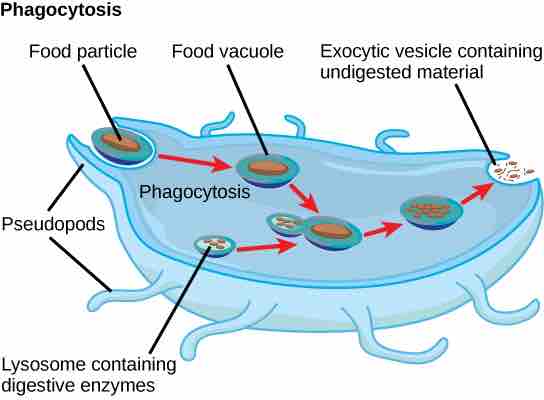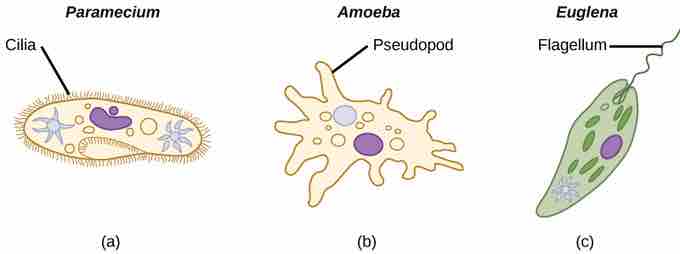Cell Structure
The cells of protists are among the most elaborate and diverse of all cells. Most protists are microscopic and unicellular, but some true multicellular forms exist. A few protists live as colonies that behave in some ways as a group of free-living cells and in other ways as a multicellular organism. Still other protists are composed of enormous, multinucleate, single cells that look like amorphous blobs of slime, or in other cases, similar to ferns. Many protist cells are multinucleated; in some species, the nuclei are different sizes and have distinct roles in protist cell function.
Single protist cells range in size from less than a micrometer to thousands of square meters (giant kelp). Animal-like cell membranes or plant-like cell walls envelope protist cells. In other protists, glassy silica-based shells or pellicles of interlocking protein strips encase the cells. The pellicle functions like a flexible coat of armor, preventing the protist from external damage without compromising its range of motion.
Metabolism
Protists exhibit many forms of nutrition and may be aerobic or anaerobic. Protists that store energy by photosynthesis belong to a group of photoautotrophs and are characterized by the presence of chloroplasts. Other protists are heterotrophic and consume organic materials (such as other organisms) to obtain nutrition. Amoebas and some other heterotrophic protist species ingest particles by a process called phagocytosis in which the cell membrane engulfs a food particle and brings it inward, pinching off an intracellular membranous sac, or vesicle, called a food vacuole . The vesicle containing the ingested particle, the phagosome, then fuses with a lysosome containing hydrolytic enzymes to produce a phagolysosome, which breaks down the food particle into small molecules that diffuse into the cytoplasm for use in cellular metabolism. Undigested remains ultimately exit the cell via exocytosis.

Protist metabolism
The stages of phagocytosis include the engulfment of a food particle, the digestion of the particle using enzymes contained within a lysosome, and the expulsion of undigested materials from the cell.
Subtypes of heterotrophs, called saprobes, absorb nutrients from dead organisms or their organic wastes. Some protists function as mixotrophs, obtaining nutrition by photoautotrophic or heterotrophic routes, depending on whether sunlight or organic nutrients are available.
Motility
The majority of protists are motile, but different types of protists have evolved varied modes of movement . Protists such as euglena have one or more flagella, which they rotate or whip to generate movement. Paramecia are covered in rows of tiny cilia that they beat to swim through liquids. Other protists, such at amoebae, form cytoplasmic extensions called pseudopodia anywhere on the cell, anchor the pseudopodia to a surface, and pull themselves forward. Some protists can move toward or away from a stimulus; a movement referred to as taxis. Protists accomplish phototaxis, movement toward light, by coupling their locomotion strategy with a light-sensing organ.

Different types of motility in protists
Protists use various methods for transportation. (a) A paramecium waves hair-like appendages called cilia. (b) An amoeba uses lobe-like pseudopodia to anchor itself to a solid surface and pull itself forward. (c) Euglena uses a whip-like tail called a flagellum.